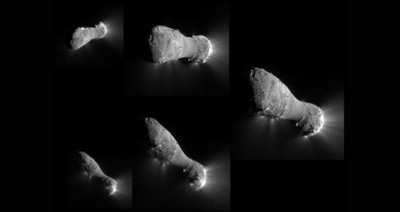Administrator Bolden Calls Rendezvous Mission "One Of NASA's
Most Successful"
NASA's EPOXI mission spacecraft successfully flew past comet
Hartley 2 at 1000 EDT Thursday. Scientists say initial images from
the flyby provide new information about the comet's volume and
material spewing from its surface.

"Early observations of the comet show that, for the first time,
we may be able to connect activity to individual features on the
nucleus," said EPOXI principal investigator Michael A'Hearn of the
University of Maryland, College Park. "We certainly have our hands
full. The images are full of great cometary data, and that's what
we hoped for."
EPOXI is an extended mission that uses the already in-flight
Deep Impact spacecraft. Its encounter phase with Hartley 2 began at
1600 EDT on Nov. 3, when the spacecraft began to point its two
imagers at the comet's nucleus. Imaging of the nucleus began one
hour later.
"The spacecraft has provided the most extensive observations of
a comet in history," said Ed Weiler, associate administrator for
NASA's Science Mission Directorate at the agency's Headquarters in
Washington. "Scientists and engineers have successfully squeezed
world class science from a re-purposed spacecraft at a fraction of
the cost to taxpayers of a new science project."

NASA Image Of Comet Hartley 2
Images from the EPOXI mission reveal comet Hartley 2 to have 100
times less volume than comet Tempel 1, the first target of Deep
Impact. More revelations about Hartley 2 are expected as analysis
continues.
Initial estimates indicate the spacecraft was about 435 miles
from the comet at the closest-approach point. That's almost the
exact distance that was calculated by engineers in advance of the
flyby.
"It is a testament to our team's skill that we nailed the flyby
distance to a comet that likes to move around the sky so much,"
said Tim Larson, EPOXI project manager at NASA's Jet Propulsion
Laboratory (JPL) in Pasadena, CA. "While it's great to see the
images coming down, there is still work to be done. We have another
three weeks of imaging during our outbound journey."
After the flyby, NASA Administrator Charles Bolden called the
mission "one of NASA's most successful deep space exploration
projects. The encounter with Hartley 2 today adds to the data
collected by the mission during Deep Impact's prime mis

Charles Bolden
sion to comet Tempel 1 in 2005 and the science acquired during
the successful EPOCh mission."
"NASA extended its pioneering exploration of the solar system
today with the successful flyby of comet Hartley 2 by our EPOXI
mission," Bolden said in a statement. "The stunning new images
returned of the comet as it zoomed past the spacecraft at a
relative speed of more than 27,000 mph are awe inspiring. The
images taken and other science collected should help reveal new
insights into the origins of our solar system as scientists pore
over them in the months and years to come. And they are also yet
another example of the incredible dedication, skill, and innovation
of the engineers and scientists at NASA, and our partners, who
accomplish these incredible technological feats.
"On behalf of the entire NASA family and interested stargazers
around the world, my congratulations to the EPOXI team for a great
moment of scientific exploration and discovery."
The name EPOXI is a combination of the names for the two
extended mission components: the Extrasolar Planet Observations and
Characterization (EPOCh), and the flyby of Comet Hartley 2, called
the Deep Impact Extended Investigation (DIXI). The spacecraft has
retained the name "Deep Impact." In 2005, Deep Impact
successfully released an impactor into the path of comet Tempel
1.
 Classic Aero-TV: In Praise of Alabamas Patriot Aircraft USA
Classic Aero-TV: In Praise of Alabamas Patriot Aircraft USA NTSB Final Report: Cirrus Design Corp SR22
NTSB Final Report: Cirrus Design Corp SR22 ANN's Daily Aero-Term (12.21.25): Dead Reckoning
ANN's Daily Aero-Term (12.21.25): Dead Reckoning ANN's Daily Aero-Linx (12.21.25)
ANN's Daily Aero-Linx (12.21.25) Aero-News: Quote of the Day (12.21.25)
Aero-News: Quote of the Day (12.21.25)





